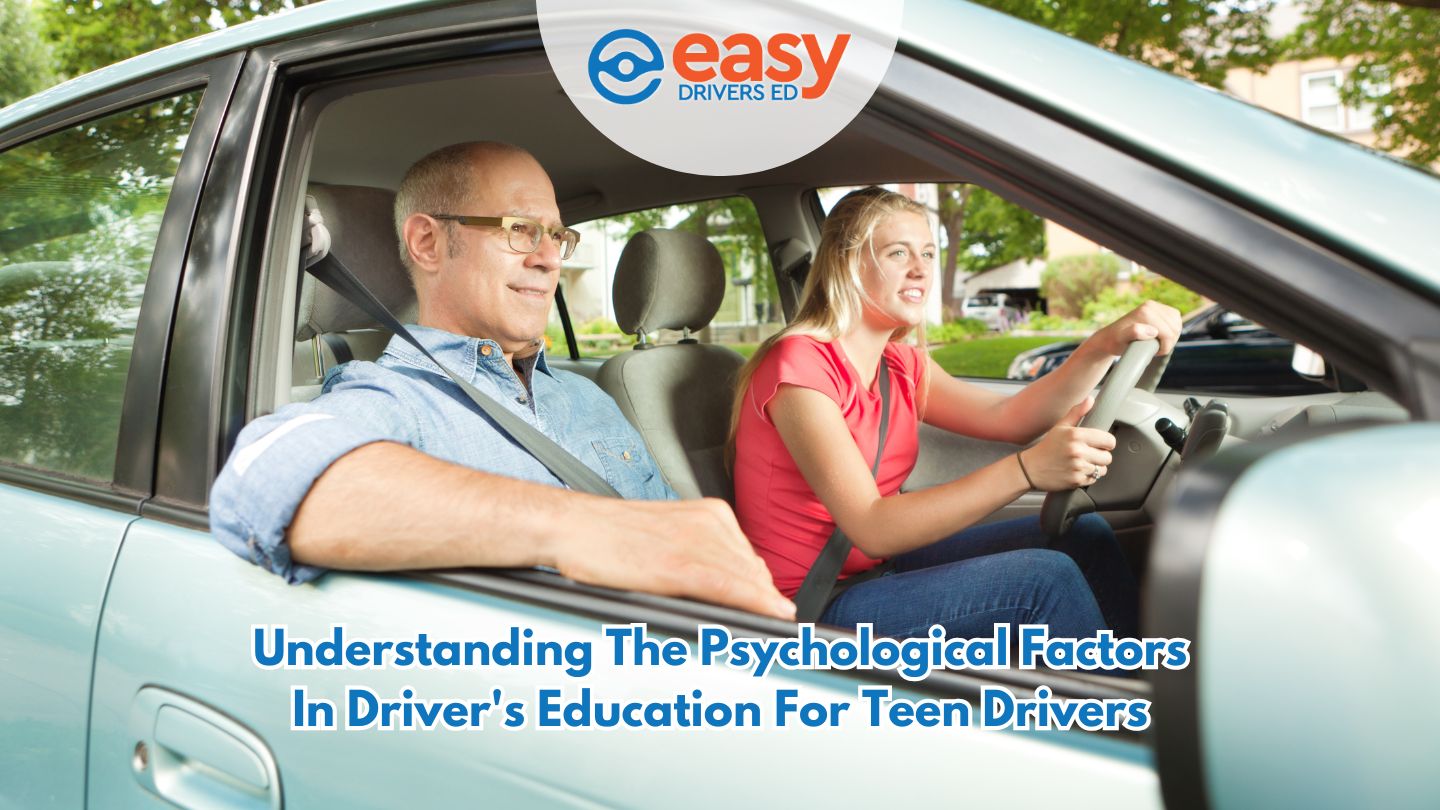Understanding the psychological factors in driver’s education for teen drivers is crucial for promoting road safety. Adolescents face unique challenges like impulsivity, poor decision-making, emotional volatility, peer pressure, and sleep deprivation. This blog will explore these psychological aspects and discuss how comprehensive driver’s education can address them, creating safer driving habits.
Key Takeaways
- The adolescent brain’s developmental immaturity leads to increased impulsivity and risk-taking behaviors in teen drivers, necessitating targeted interventions to promote safer driving practices.
- Emotional regulation and peer influence significantly affect decision-making and driving behaviors among young drivers, highlighting the need for structured education on managing emotions and making responsible choices behind the wheel.
- Graduated Driver Licensing (GDL) systems, supported by state-approved education programs, are effective in reducing crash rates among novice drivers by gradually introducing driving complexities and limiting exposure to high-risk situations.
The Adolescent Brain and Driving
The adolescent brain is intricate and still evolving, prompting teenagers to pursue more hazardous activities due to a natural urge for exploration. This developmental phase presents distinct challenges in the realm of driving.
During adolescence, the prefrontal cortex—the part of the brain responsible for regulating impulses and making thoughtful decisions—remains underdeveloped. This gap can lead to impulsivity and a tendency to underestimate risk. These traits, when paired with inexperience on the road, often result in behaviors such as speeding, tailgating, or using mobile devices while driving.
Adding to this challenge is a teen’s heightened sensitivity to rewards. This makes risky behaviors like rapid acceleration or competitive driving feel thrilling, even when the dangers are significant. Addressing these tendencies early on through structured education is key to developing safer long-term driving habits. Effective online programs can reinforce awareness of these risks and instill caution through scenario-based learning, which mirrors real-world situations teens may encounter.
Decision-Making in Teen Drivers
Young drivers often make decisions differently than adults due to the uneven development of the brain. While their ability to respond to rewards is fully formed, the part responsible for assessing risk and consequences—the prefrontal cortex—matures more slowly. This can cause adolescents to rely on gut feelings or emotional impulses rather than rational judgment.
As a result, teens may overestimate their driving skills or downplay the likelihood of a crash. This optimism bias can lead to dangerous behaviors like weaving through traffic or ignoring road signs. Structured driver education plays a critical role in helping young drivers recognize and correct these cognitive distortions.
Courses that include judgment training modules can simulate complex traffic scenarios, encouraging teens to weigh their options and reflect on the safest course of action. These tools help offset overconfidence and guide teens toward safer, more calculated driving behaviors.
Emotional Regulation and Its Impact on Driving Safety
Emotions play a significant role in driving safety, particularly for teens who are still developing emotional regulation skills. High-stress emotions like frustration, anxiety, or anger can impair reaction times, cloud judgment, and increase the risk of errors behind the wheel.
For example, anger is a leading contributor to aggressive driving behaviors, such as tailgating or sudden lane changes, which drastically raise accident risks. These emotional responses are especially concerning for young drivers, who may not yet have the tools to manage them effectively.
Professional driver education programs address this issue by integrating emotional awareness into the curriculum. Through interactive learning and scenario-based instruction, teens learn how emotional states can affect reaction time and decision-making. Rather than relying on self-guided calming techniques, students are taught structured strategies—like recognizing emotional triggers and safely adjusting their behavior—that empower them to stay composed and focused during high-pressure driving situations.
Peer Influence and Driving Behavior
Peer influence plays a critical role in teen driving behavior. The presence of friends in a vehicle can significantly increase the likelihood of risky driving, particularly if those peers encourage speeding, stunts, or distractions like loud music or mobile phone use.
Teen drivers may prioritize impressing their peers over making safe choices, especially when they perceive social rewards for showing off or taking risks. In fact, research shows that crash rates increase when teen drivers have other teenagers as passengers due to the added pressure and distraction.
However, professional training environments help teens recognize and resist negative peer influence. By presenting real-life examples and including social pressure scenarios in learning modules, these programs teach students how to assert safe boundaries and make independent decisions. Positive peer influence is also explored, encouraging students to be role models who promote caution and responsibility when in the driver’s seat.
Sleep Deprivation and Its Effects on Driving
Sleep deprivation is a significant concern for teen drivers. Biological changes during adolescence, combined with academic demands and social obligations, often lead to chronic sleep shortages. This lack of rest affects reaction time, attention span, and overall decision-making—critical components of safe driving.
Many teens report driving while tired, especially during early morning or late-night hours. Fatigue impairs alertness and increases the risk of drowsy-driving crashes. Some teens may turn to caffeine or energy drinks to stay awake, which may mask tiredness but not restore full cognitive function.
Comprehensive driver education programs educate students on the dangers of drowsy driving and provide guidelines for recognizing fatigue-related symptoms. By integrating fatigue management strategies into formal lessons, students learn when it’s unsafe to drive and how to plan trips with rest in mind. These lessons are designed to instill lifelong habits around sleep hygiene and driving readiness.
The Role of Graduated Driver Licensing Systems
Graduated Driver Licensing (GDL) systems are structured to help teens ease into driving by progressing through stages of responsibility. These typically include obtaining a learner’s permit, moving to an intermediate license, and eventually earning full driving privileges. Each stage introduces new driving responsibilities while limiting high-risk situations, such as nighttime driving or transporting teen passengers.
While the GDL system is implemented by the state, its effectiveness is greatly enhanced when paired with high-quality driver education. Online programs designed to align with GDL principles help teens prepare for each stage by offering in-depth knowledge, situational awareness, and defensive driving techniques.
These programs equip students with the tools to understand and follow GDL restrictions, ensuring that they gain the right experience under low-risk conditions. Ultimately, combining structured education with GDL protocols leads to safer, more confident teen drivers.
Defensive Driving Techniques for Teens
Defensive driving is a crucial skill set for teens, enabling them to anticipate hazards, respond calmly under pressure, and avoid crashes. In 2022, speeding was involved in 30% of fatal vehicle crashes involving teenage drivers—underscoring the need for speed management and awareness.
Distracted driving, particularly due to texting or phone use, also remains a leading cause of teen-related crashes. Teens must be taught not only about the legal consequences of phone use while driving but also about the life-threatening risks it poses.
Professional driver education courses cover these topics in depth. Teens learn how to scan for hazards, maintain safe following distances, and respond proactively to unpredictable drivers or road conditions. Lessons also reinforce the life-saving importance of wearing seat belts, a habit that could have prevented half of the teen driving fatalities recorded in 2022.
Rather than relying on trial and error, students benefit from structured instruction that fosters decision-making skills and ingrains safe behaviors—well before they’re tested on the road.
The Importance of Professional Driver Education
Undergoing professional driver education is crucial in fostering good driving habits among young drivers. By participating in a driver’s education course, new drivers can enjoy substantial insurance discounts as an incentive for engaging in formal training. Attending such courses may aid in reducing points on one’s driving record, which can enhance their overall driving status and help avoid severe long-term consequences associated with poor driving records. The impact of psychosocial factors on youths’ perception of the value of these educational programs underscores the necessity for well-structured instructional settings.
Initiatives like EasyDriversEd offer thorough and methodical instruction tailored to empower learner drivers with safer driving techniques. These programs are meticulously crafted to tackle specific obstacles that novice drivers encounter and encourage the establishment of positive driving practices designed to benefit them throughout their lives.
Summary
Understanding the psychological factors that influence young drivers’ behavior is crucial for promoting safer driving practices. The developmental phases of a teenager’s brain, coupled with external influences such as peer pressure, fatigue, and emotional responses, significantly impact their driving approach. Addressing these risk factors through education contributes to safer roads and more confident drivers.
At EasyDriversEd, we are dedicated to equipping teens with the skills to face these challenges through our driver’s education in Houston. Our state-approved online course offers a structured curriculum that helps new drivers understand risks, develop decision-making skills, and build the confidence needed for safe navigation on the road. Contact us today to empower your teen with the tools for a lifetime of responsible driving.
Frequently Asked Questions
1. How do emotions like stress or anger affect teen driving performance?
Strong emotions can impair reaction time, reduce focus, and increase the likelihood of risky driving behaviors like speeding or tailgating.
2. Why are teens more likely to underestimate driving risks?
Due to brain development, teens often prioritize short-term rewards and may not fully grasp the long-term consequences of risky decisions behind the wheel.
3. Can peer passengers really influence how safely a teen drives?
Yes, having peers in the car can increase distraction and pressure to take risks, especially when teens are still gaining experience and confidence.




